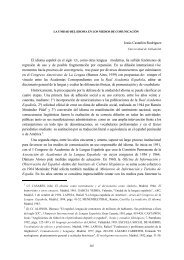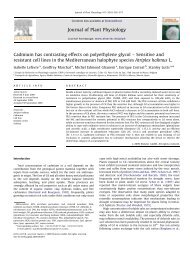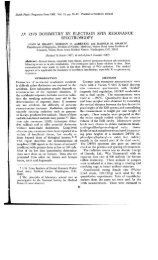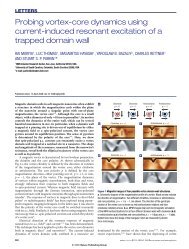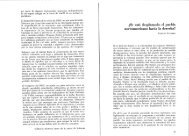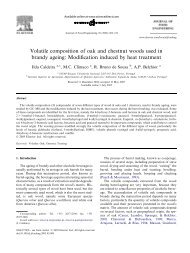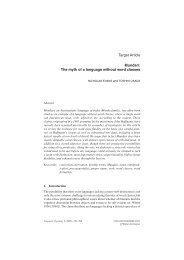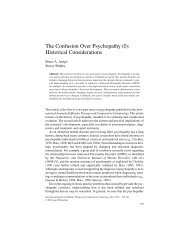Terpenoids: Opportunities for Biosynthesis of Natural Product Drugs ...
Terpenoids: Opportunities for Biosynthesis of Natural Product Drugs ...
Terpenoids: Opportunities for Biosynthesis of Natural Product Drugs ...
Create successful ePaper yourself
Turn your PDF publications into a flip-book with our unique Google optimized e-Paper software.
eviews Ajikumar et al.<br />
The next two steps in the pathway are the least understood<br />
and catalyzed by the enzymes 1-hydroxy-2-methyl-2-(E)butenyl-4-diphosphate<br />
synthase (IspG) and 4-hydroxy-3methyl-2-(E)-butenyl-4-diphosphate<br />
reductase (IspH). 149,150<br />
IspG trans<strong>for</strong>ms MECP to 2-methyl-2-(E)-butenyl diphosphate<br />
followed by the enzyme IspH, catalyzing the conversion<br />
to IPP. 151 IspH also catalyzes the <strong>for</strong>mation <strong>of</strong> some<br />
DMAPP as well. The last enzyme in the universal precursor<br />
pathway is isopentenyl-diphosphate isomerase (IDI), which<br />
isomerizes the IPP carbon-carbon double bond <strong>for</strong> steriospecifc<br />
conversion to DMAPP. 152 Type I and type II IDI<br />
isomerases are characterized. IDI-I is dependent on divalent<br />
cations (Mn 2+ or Mg 2+ ) and is widely distributed in<br />
eukaryotes and eubacteria. 153,154 The type II enzyme was<br />
recently discovered and only present in Streptomyces sp.<br />
strain CL190, archaea, and eubacteria. 155 It is interesting to<br />
note that the non-mevalonate pathway is not regulated in<br />
the same way as the MVA pathway. 136 To date there have<br />
been no global transcriptional regulators identified. The<br />
enzymes IspD and IspF involved in steps three and five are<br />
expressed as a bifunctional enzyme IspDF. This fusion is<br />
unusual because, unlike most bifunctional enzymes, it<br />
catalyzes nonconsecutive steps.<br />
The Downstream Biosynthetic Pathways: Building<br />
Diversity from a Common Precursor. Starting from the<br />
universal precursors IPP and DMAPP, thousands <strong>of</strong> enzymes<br />
are involved in the biosynthetic pathways <strong>for</strong> terpenoids chain<br />
elongation, cyclization, and functionalization <strong>of</strong> hydrocarbon<br />
(149) Grawert, T.; Kaiser, J.; Zepeck, F.; Laupitz, R.; Hecht, S.;<br />
Amslinger, S.; Schramek, N.; Schleicher, E.; Weber, S.; Haslbeck,<br />
M.; Buchner, J.; Rieder, C.; Arigoni, D.; Bacher, A.;<br />
Eisenreich, W.; Rohdich, F. IspH protein <strong>of</strong> Escherichia coli:<br />
studies on iron-sulfur cluster implementation and catalysis. J. Am.<br />
Chem. Soc. 2004, 126, 12847–12855.<br />
(150) Puan, K. J.; Wang, H.; Dairi, T.; Kuzuyama, T.; Morita, C. T.<br />
fldA is an essential gene required in the 2-C-methyl-D-erythritol<br />
4-phosphate pathway <strong>for</strong> isoprenoid biosynthesis. FEBS Lett.<br />
2005, 579, 3802–3806.<br />
(151) Gabrielsen, M.; Bond, C. S.; Hallyburton, I.; Hecht, S.; Bacher,<br />
A.; Eisenreich, W.; Rohdich, F.; Hunter, W. N. Hexameric<br />
assembly <strong>of</strong> the bifunctional methylerythritol 2,4-cyclodiphosphate<br />
synthase and protein-protein associations in the deoxyxylulose-dependent<br />
pathway <strong>of</strong> isoprenoid precursor biosynthesis.<br />
J. Biol. Chem. 2004, 279, 52753–52761.<br />
(152) Wouters, J.; Oudjama, Y.; Ghosh, S.; Stalon, V.; Droogmans,<br />
L.; Oldfield, E. Structure and mechanism <strong>of</strong> action <strong>of</strong> isopentenylpyrophosphate-dimethylallylpyrophosphate<br />
isomerase.<br />
J. Am. Chem. Soc. 2003, 125, 3198–3199.<br />
(153) Durbecq, V.; Sainz, G.; Oudjama, Y.; Clantin, B.; Bompard-<br />
Gilles, C.; Tricot, C.; Caillet, J.; Stalon, V.; Droogmans, L.;<br />
Villeret, V. Crystal structure <strong>of</strong> isopentenyl diphosphate:dimethylallyl<br />
diphosphate isomerase. EMBO J. 2001, 20, 1530–1537.<br />
(154) Zhang, C.; Liu, L.; Xu, H.; Wei, Z.; Wang, Y.; Lin, Y.; Gong.<br />
W. Crystal structures <strong>of</strong> human IPP isomerase: new insights into<br />
the catalytic mechanism. J. Mol. Biol. 2006, 366, 1437–1446.<br />
(155) Hamano, Y.; Dairi, T.; Yamamoto, M.; Kawasaki, T.; Kaneda,<br />
K.; Kuzuyama, T.; Itoh, N.; Seto, H. Cloning <strong>of</strong> a gene cluster<br />
encoding enzymes responsible <strong>for</strong> the mevalonate pathway from<br />
a terpenoid-antibiotic-producing Streptomyces strain. Biosci.<br />
Biotechnol. Biochem. 2001, 65, 1627.<br />
178 MOLECULAR PHARMACEUTICS VOL. 5, NO. 2<br />
chains to create enormous chemical and structural diversity.<br />
132,133,156 Among these, only a few hundred have been<br />
studied in detail. From the two basic building blocks, IPP and<br />
DMAPP, a group <strong>of</strong> enzymes called prenyltransferases catalyze<br />
the synthesis <strong>of</strong> linear prenyl diphosphates such as geranyl<br />
diphosphate (GPP), farnesyl diphosphate (FPP), geranylgeranyl<br />
diphosphate (GGPP), and farnesyl geranyl diphosphate (FGPP),<br />
up to natural rubber with a carbon chain <strong>of</strong> several million in<br />
length (Figure 3). 157 During biosynthesis, the active isoprene<br />
unit (IPP) is repeatedly added to DMAPP or a prenyl diphosphate<br />
in sequential head-to-tail condensations. The reaction starts<br />
with the elimination <strong>of</strong> a diphosphate ion from an allylic<br />
diphosphate to <strong>for</strong>m an allylic cation, which is attacked by an<br />
IPP molecule with steriospecific removal <strong>of</strong> a proton to <strong>for</strong>m<br />
new carbon-carbon bonds in the product molecule. Through<br />
consecutive condensations <strong>of</strong> IPP with allylic prenyl diphosphate,<br />
a prenyltransferase can synthesize a variety <strong>of</strong> molecules<br />
with fixed lengths and stereochemistry. All prenyltransferases<br />
require divalent metal ions such as Mg 2+ or Mn 2+ <strong>for</strong> catalysis.<br />
Prenyltransferases geranyl pyrophosphate synthase (GPS) and<br />
farnesyl pyrophosphate synthase (FPPS) catalyze the condensation<br />
<strong>of</strong> IPP and DMAPP <strong>for</strong> the <strong>for</strong>mation <strong>of</strong> GPP (C10) and<br />
FPP (C15), precursors <strong>for</strong> monoterpenes and sesquiterpenes,<br />
respectively. 158,159 Geranylgeranyl pyrophosphate synthase<br />
(GGPPS) and farnesyl geranyl pyrophosphate synthase (FGPPS)<br />
catalyze the condensations to GGPP (C20) and FGPP (C25),<br />
precursors <strong>for</strong> diterpene and sesterterpene, respectively. Many<br />
functional terpenoids are synthesized from linear prenyl diphosphates<br />
through cyclization cascades, the most complex chemical<br />
reactions known in chemistry and biology. 7,133,156,160 The<br />
structural diversity in terpenoids is initiated by the differences<br />
in folding <strong>of</strong> the substrate in the active site <strong>of</strong> the terpenoid<br />
cyclase followed by the generation and propagation <strong>of</strong> carbocationic<br />
intermediates, which readily undergo dramatic<br />
structural rearrangements. Most <strong>of</strong> these reactions happen under<br />
strict sterochemical and regiochemical precision, and two-thirds<br />
<strong>of</strong> the substrate carbon atoms undergo changes in chemical<br />
bonding and/or hybridization to <strong>for</strong>m a single, unique terpenoid<br />
molecule.<br />
<strong>Terpenoids</strong> are typically classified based on the number<br />
<strong>of</strong> five carbon isoprene units in their linear precursor prenyl<br />
disphosphate as C5 hemiterpenes, C10 monoterpenes, C15<br />
(156) Trapp, S. C.; Croteau, R. B. Genomic organization <strong>of</strong> plant<br />
terpene synthases and molecular evolutionary implications.<br />
Genetics 2001, 158, 811–832.<br />
(157) Ogura, K.; Koyama, T. Enzymatic Aspects <strong>of</strong> Isoprenoid Chain<br />
Elongation. Chem. ReV. 1998, 98, 1263–1276.<br />
(158) Ohnuma, S.; Hirooka, K.; Tsuruoka, N.; Yano, M.; Ohto, C.;<br />
Nakane, H.; Nishino, T. A pathway where polyprenyl diphosphate<br />
elongates in prenyltransferase. Insight into a common<br />
mechanism <strong>of</strong> chain length determination <strong>of</strong> prenyltransferases.<br />
J. Biol. Chem. 1998, 273, 26705–26713.<br />
(159) Wang, K. C.; Ohnuma, S. Isoprenyl diphosphate synthases.<br />
Biochim. Biophys. Acta 2000, 1529, 33–48.<br />
(160) Lesburg, C. A.; Caruthers, J. M.; Paschall, C. M.; Christianson,<br />
D. W. Managing and manipulating carbocations in biology:<br />
terpenoid cyclase structure and mechanism. Curr. Opin. Struct.<br />
Biol. 1998, 8, 695–703.



